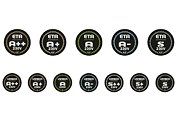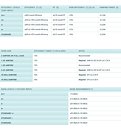Monday, January 29th 2018
Cybenetics Announces New ETA-230V and LAMBDA-230V Certifications
Cybenetics was formed with one purpose in mind; to bring revolution to the efficiency and noise certification standards of personal computer power supply units (PSUs) through the ETA (efficiency) and LAMBDA (noise) programs.
Both programs mentioned above use 115 VAC input mainly. Given the increased demand for 230 VAC results, we decided to initiate two new programs, the ETA-230V and LAMBDA-230V. The general methodologies that the new programs follow are identical to the ones used by the 115 V programs, with the main differences being the 230 V input and the different limits/ranges in the ETA-230V.Contrary to other efficiency rating programs that test only three or four different load points; the ETA-230V program, like the original ETA program, is based on the efficiency results of thousands of different load combinations which are obtained through a unique custom-made application. This process allows Cybenetics to use a single value rating to represent PSU's true overall efficiency. Moreover, and very importantly, Power Factor, Vampire Power and the +5VSB rail's efficiency are also taken into consideration in the final rating, whereas these are not even considered in other efficiency certification programs. Finally, the PSUs must be compliant with the CEC, ErP Lot 6 2010/2013 and ErP lot 3 2014 directives and also meet all requirements mentioned in the (EU) No 617/2013 regulation:
The efficiency targets required by CEC, ErP Lot 6 2010/2013 and ErP lot 3 2014 directives are depicted below.
LAMBDA-230V: Utilizing an advanced methodology and a highly sophisticated control/monitor program, the power supply's noise readings throughout its entire operational range are recorded and through those an overall noise reading derives. As of this time and to the best of our knowledge, there is no other noise certification program available for IT products and our purpose is to expand this program to other hardware parts, besides PSUs, in the future.
The LAMBDA-230V program consists of seven levels (A++, A+, A, A-, S++, S+, S). Each certification badge is tied to the specific product through a short-URL and a QR code, which will be printed on it. This will allow users to easily find a PSU's evaluation report certified by Cybenetics.
Since Cybenetics wants to offer as detailed as possible evaluation reports in addition to the normal test results, it also includes a number of other results (efficiency and load regulation at 10%-110% load, ripple performance, hold-up time, part analysis etc.), which will be helpful not only to everyday users but to experienced ones and PSU reviewers as well, who don't have the proper equipment and software to follow our methodology.
You can find more information about Cybenetics, the ETA, ETA-230V and LAMBDA, LAMBDA-230V certification programs, at www.cybenetics.com.
Both programs mentioned above use 115 VAC input mainly. Given the increased demand for 230 VAC results, we decided to initiate two new programs, the ETA-230V and LAMBDA-230V. The general methodologies that the new programs follow are identical to the ones used by the 115 V programs, with the main differences being the 230 V input and the different limits/ranges in the ETA-230V.Contrary to other efficiency rating programs that test only three or four different load points; the ETA-230V program, like the original ETA program, is based on the efficiency results of thousands of different load combinations which are obtained through a unique custom-made application. This process allows Cybenetics to use a single value rating to represent PSU's true overall efficiency. Moreover, and very importantly, Power Factor, Vampire Power and the +5VSB rail's efficiency are also taken into consideration in the final rating, whereas these are not even considered in other efficiency certification programs. Finally, the PSUs must be compliant with the CEC, ErP Lot 6 2010/2013 and ErP lot 3 2014 directives and also meet all requirements mentioned in the (EU) No 617/2013 regulation:
- (a) 85% efficiency at 50% of rated output power;
- (b) 82% efficiency at 20% and 100% of rated output power;
- (c) power factor = 0.9 at 100% of rated output power.
The efficiency targets required by CEC, ErP Lot 6 2010/2013 and ErP lot 3 2014 directives are depicted below.
LAMBDA-230V: Utilizing an advanced methodology and a highly sophisticated control/monitor program, the power supply's noise readings throughout its entire operational range are recorded and through those an overall noise reading derives. As of this time and to the best of our knowledge, there is no other noise certification program available for IT products and our purpose is to expand this program to other hardware parts, besides PSUs, in the future.
The LAMBDA-230V program consists of seven levels (A++, A+, A, A-, S++, S+, S). Each certification badge is tied to the specific product through a short-URL and a QR code, which will be printed on it. This will allow users to easily find a PSU's evaluation report certified by Cybenetics.
Since Cybenetics wants to offer as detailed as possible evaluation reports in addition to the normal test results, it also includes a number of other results (efficiency and load regulation at 10%-110% load, ripple performance, hold-up time, part analysis etc.), which will be helpful not only to everyday users but to experienced ones and PSU reviewers as well, who don't have the proper equipment and software to follow our methodology.
You can find more information about Cybenetics, the ETA, ETA-230V and LAMBDA, LAMBDA-230V certification programs, at www.cybenetics.com.


6 Comments on Cybenetics Announces New ETA-230V and LAMBDA-230V Certifications
Those ratings are meant for buyers and make things more simple, as a result, fail to see it how it makes things simpler, bad or not bad, that's not the issue... actually this thing just ads more to alienate from understanding truly a simple thing should have contained just the familiar number or range what was thought in school for everyone actually. My preference would be a small and simple XY graph with all the needed plots.
The noise chart includes also funny facts, they average it from all load levels, if the end ramp is steep at maximum load, but in reality never used by the user and even has a hybrid fan mode till 50% load, it would give a false perception of the class ie worse. For example my Fractal Newton R3 turns on a fan after a certain time even in idle how do they measure and value that, whistle and show a yellow card? And when it does it is fairly loud. So well... it is all bittersweet. You will notloose your job for sure as each product should be judged individually still and reviews and reviewers like you are and will be needed.
Congrats on 666 post lmao.
As for noise measurements, this is the best system and was devised after 9 years of work. What affects the most the final noise rating isn't the low RPM but the mid and high-ones so semi-passive units even when are tested with the semi-passive mode deactivated (if this can be done of course) still the final noise rating is really close.
Also there is a red/yellow or what ever region at the low noise readings simply because the equipment cannot go lower than 6 dBA. Still I believe that 6 dBA is a damn low noise floor and very few labs worldwide are able to hit it.